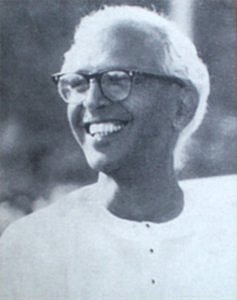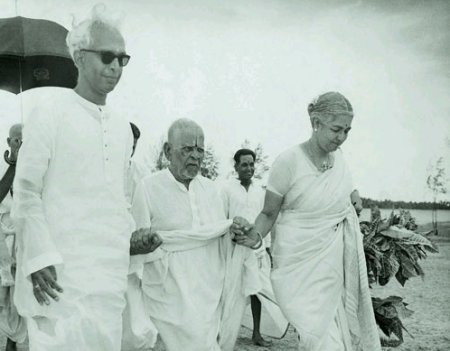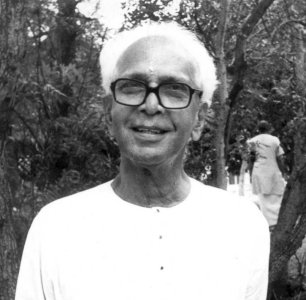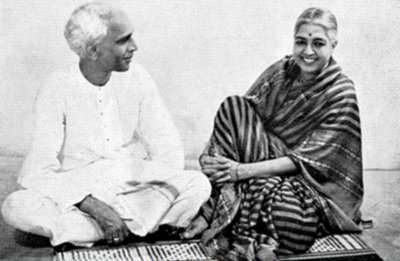 |
  |
 |
  |
K Sankara Menon: 1907 - 1995 - Compiled by Lalitha Venkat e-mail: lalvenkat@yahoo.com February 10, 2008  Lives of great men all remind us We can make our lives sublime And departing, leave behind us Footprints on the sands of time Sankara Menon was the youngest of three sons of Vengalil Sankara Menon and Kariottukalathil Kalyani amma. From the age of 2, he was placed in the care of his maternal grandmother and aunt at Pandarakalam, the joint family home, while his two elder brothers stayed with their father in Calicut where he had a law practice. When he was older, he joined his brothers in Calicut to complete his schooling. Sankara Menon’s association with the Arundales began in the Thirties when as a boy he came to Madras from Kerala to join the Presidency College. His elder brother Narayana Menon was a Theosophist and so was his cousin VK Krishna Menon. That is how he got interested in Theosophy. Though he never knew Dr. Besant personally, he worshipped her from afar and heard her speak many times. He became attached to Dr.GS Arundale and Rukmini Devi after he joined the Theosophical Society. I first saw Dr.Arundale in 1923. I had come to Madras from my home in Kerala at the age of fifteen to join the Presidency College as a student. I was keenly interested in scouting and was an active member of the Scout Organizations. One of the functions arranged in 1923 by our unit, was presided over by Dr. Arundale. I first met and spoke to Dr. Arundale in the year 1927. I had joined the Theosophical Society in 1925 and was an active member of the Young Theosophists movement. Annie Besant passed way in 1933. Shortly before her death, Dr. Besant stressed the need of a school at Adyar. At that time, Dr. Arundale and Rukmini Devi were living in the Guest House near the Headquarters in the Theosophical Society's estate, and a number of us used to meet there every day. The main topic of conversation was the establishment of Dr. Besant's school. Dr. Arundale used to say that the one factor that we had to discover and determine was a good Headmaster for the school. We searched high and low among the people we knew, but found no one suitable. One day, in the evening, I was turning into the Guest House and saw Dr. Arundale on the veranda of the house. He pointed his finger in my direction and said, "Ah! There comes the Headmaster." I had been so much a part of the discussions regarding all this but never thought that I was going to be a teacher. So I presumed, when he pointed in my direction, that he was greeting someone arriving behind me and turned round to see who it was. Dr. Arundale was amused and he said, "I mean you." I protested that teaching was a profession in which I had no interest and I could not see myself occupying so important a place as Headmaster in Dr. Besant’s High School. Moreover, I had had no experience of teaching and would be in no position to direct other teachers. I was then a Research Fellow in Madras University with published papers to my credit and was all set to become a research scientist for the rest of my life. Dr. Arundale did not seem to feel my lack of experience and absence of interest an obstacle. He said, "Your inexperience is a favorable factor because you have no preconceived notions that I have to knock out of your head and I can lick you into shape properly. As for interest in teaching, that will come. Give up all that research nonsense and come and help establish the school." I was so attached to him that I did not dream of doubting his word or hesitating to accept his advice. I promptly gave up my research work in the University and started to prepare to open what was to be called the Besant Memorial High School during the ensuing year, to wit in June 1934. ('George Sydney Arundale as I knew him' by K Sankara Menon) At 27, Sankara Menon was the youngest Principal who was fresh from college and who had no formal training in teaching methodology. Dr. Arundale himself was a great educationist, effective and popular, who had headed the school and college established by Besant in Banaras. As Headmaster of the school, Sankara Menon was much loved. According to G.Sundari who was an early pupil of the school, "The children would cluster around him adoringly whenever he visited the classrooms. When he took over the administration of Kalakshetra it was a great loss to the teaching world for though not trained as an educator, he was a born teacher." Sankara Menon organized the first Montessori Training Course in the country in 1939 and earned encomiums from Madame Montessori who said he understood her educational principles better than anyone. I have no hesitation in saying that the School owes to its Headmaster the reputation it has gained for all-round excellence among the general public and the educational authorities. And while no one is absolutely indispensable, our Headmaster is certainly almost indispensable, as we realize on the rare occasions he has to be away. I should like to add that the school's unblemished success as a co-educational institution is very largely due to his own example of reverence and chivalry. - Dr. GS Arundale (Note in the Young Citizen, July 1942) Sankara Menon served as the Headmaster of Besant Theosophical High School between1934-46. In 1946-47, after his return from Europe where he had been taken ill and was looked after by kind friends Dickie and Graham Boag, he was still considered to be in delicate health and advised to go to the hill stations and avoid the Madras summer. His duties were now different from those of his early association. He had to organize the Besant Centenary Trust, consolidate the various institutions, secure donations, grants and support to make the barren land habitable with trees and buildings – all this without allowing the institutions to fold up. All along, the expansion of the institutions was more than the resources. On January 1, 1951, a banyan sapling was planted in the new campus. Kalakshetra eventually moved to Thiruvanmiyur.  Sankara Menon, Mysore Vasudevachariar, Rukmini Devi When Rukmini Devi started the Kalakshetra in 1936 and ushered in glorious cultural renaissance in the country, she asked Sankara Menon to help. He stood by her as trusted lieutenant, able administrator and staunch supporter. It was the golden years of Kalakshetra, an era of giants with people such as Sankara Menon, Rukmini Devi, Papanasam Sivan, Mysore Vasudevachar, Samba Siva Iyer, Boodaloor Krishnamurthy Sastrigal, MD Ramanathan, Pudukkode Krishnamurthy, Mylapore Gauri Ammal and Chandu Panikkar. "Though I love music and dance, I do not know anything about them," he would say. But according to those around him, his knowledge of music was so comprehensive that many a time when a vidwan paused in his recital, Sankara Menon would supply him the missing word or line. His intuitive understanding and knowledge were such that great musicians like Vasudevachar would compose songs and then send them to Sankara Menon for approval while he was in the midst of his administrative work. Often, Rukmini Devi would cast people she knew, even famous personalities, in roles in her dance dramas. A luxuriant beard would mean an ideal “rishi.” A few hours of rehearsal and she would prime the person for the role. Sankara Menon too donned quite a few parts in dramas and even helped out in emergencies. "As Siddartha in 'The Light of Asia' he was remarkable. Even if he appeared for just a fleeting moment as in 'Sita Swayamvaram,' his tall and majestic form left quite an impact," recalls Peria Sarada who was head of the Department of Dance for many years at Kalakshetra.  Sankara Menon was instrumental in translating Rukmini Devi's dreams into reality. It was he who attended to the day-to-day function of Kalakshetra. In fact, Rukmini Devi used to say with affection, "When people come to Kalakshetra, they always look for Sankara Menon." Sankara Menon was a man of two worlds, the world of science and the world of art. He did brilliantly at school and college, particularly in science. He was hardly out of his teens when he obtained a research scholarship and then a research studentship and his specialty was Marine Biology. But Sankara Menon went on to the realm of art and there too, he distinguished himself. How did Sankara Menon manage to change from Science to Art and Education? It was the result of one person's magnetism, Annie Besant. Sankara Menon fell under her spell, and when she passed away, he fell under the spell of Dr. Arundale and the equally irresistible spell of Rukmini Devi. By describing him as a man of two worlds, that he belonged to the world of science as well as art, one could also say he belonged to the East as well as the West. Sankara Menon's knowledge of the Upanishads and Vedas, which was immense, was matched by his mastery of Shakespeare’s works. His Bhagavad Gita classes held under the auspices of the Besant Lodge were attended by young and old. His philosophical interpretation of the Gita Govinda was an experience in itself, say those who have heard him. He was nearly six feet tall, held himself straight and was always clad in spotless white kurta and dhoti. His memory power was extraordinary. His keen intellect, encyclopedic knowledge and humane qualities benefited the centre immensely and endeared him to all those who came in contact with him. Sankara Menon truly was an institution by himself, an "intellectual giant" with a rare level of erudition in such diverse fields as art, music, literature, religion, philosophy, morality and politics. The short lectures that he often gave during the morning assembly under the Banyan tree of Kalakshetra had a large and faithful following. Sankara Menon was not only a lover of dance but also a great admirer of South Indian classical music and his philosophy was to establish a clear identity for any art form so as to maintain its purity. As a man of great principle, he was absolutely uncompromising in his endeavour to promote art in its pure, undiluted form. Kalakshetra came to symbolize such ideals, something that could only be achieved through discipline, unity in focus and sustained effort. While Rukmini Devi was undoubtedly the heart of Kalakshetra, Sankara Menon was the man at the helm, the skipper of the ship. But he would modestly say, "My role is small, I only helped her. Rukmini Devi was a remarkably gifted individual, a lady of great vision who had an in-depth knowledge of the arts. I was only her right hand."  Sankara Menon, Rukmini Devi ...In the building of our educational and cultural work, I could not have done anything without the help of so many friends, both in and outside the Theosophical Society. I must specially mention Sri Sankara Menon whom I have not thanked at all at any meeting owing to the fact that no words are adequate. A distinguished person, who would have made a mark in the world, came as a Headmaster to our little school when Dr. Arundale asked him to help us. He gave up everything and my gratitude is not only because of all that he did for Dr. Arundale and myself, but because he has continued to work ever increasingly with remarkable devotion and disinterestedness. He proved an ideal teacher for the young and is an example of integrity, learning and unselfishness. - Rukmini Devi (In President’s Letter, April 1964) Sankara Menon was Joint Director of Kalakshetra and after Rukmini Devi passed away in 1986, he became the Director. When in 1993 the Government took over Kalakshetra, the honour of being the first Director of the Kalakshetra Foundation was bestowed on Sankara Menon and that was the time when Kalakshetra got recognized as an institution of national importance by the University Grants Commission. Extremely learned in Malayalam, English and Sanskrit and a fine orator as well, his accomplishments sat lightly on him. For him, there was no difference between Sankara Menon and Kalakshetra. The statement carried conviction for he never married and completely devoted himself to the service of the institution. In his last years, even after some thugs brutally attacked him, leaving him rather badly injured, his indomitable spirit never left him. Poised, calm and even-tempered, K Sankara Menon was a Renaissance man; an aesthete, a scholar, and above all, a man who lived his life in the manner he considered to be of most value to him. From 1934 till he breathed his last in 1995, he devoted himself entirely to Kalakshetra; he had no other interest in life. Though he was born in an affluent family in Kerala, he did not even care to stake his claim over his rich ancestral property, once he decided to dedicate himself to the cause of Indian art and culture. He lived in a small cottage next to Arundale House in Theosophical Society, which was Rukmini Devi's residence. After she passed away, he moved to Kalakshetra where a friend had built a cottage for him. He lived there, attending to all the work of Kalakshetra till the end. "As luck would have it, or maybe this is what Sankara Menon would have wished, I had the opportunity to place his mortal body on the pyre, as a son would do the last rites. No other members of Kalakshetra who were working there then were there when he passed away to do the last rites," recalls VP Dhananjayan. Sankara Menon died on November 17, 1995. That was the day and month that the Theosophical Society was founded in 1875. The above piece is excerpted from various articles featured in the book SANKARA MENON: PURUSHOTHAMAN, edited by G Sundari and published by his grand niece Indu Jayanthi Varma for The People for Children Foundation. It was released on September 22, 2007 to commemorate Sankara Menon’s birth centenary. The book contains scholarly articles by Sankara Menon and tributes paid to him by his friends and past students at the Besant Theosophical High School and Kalakshetra. |